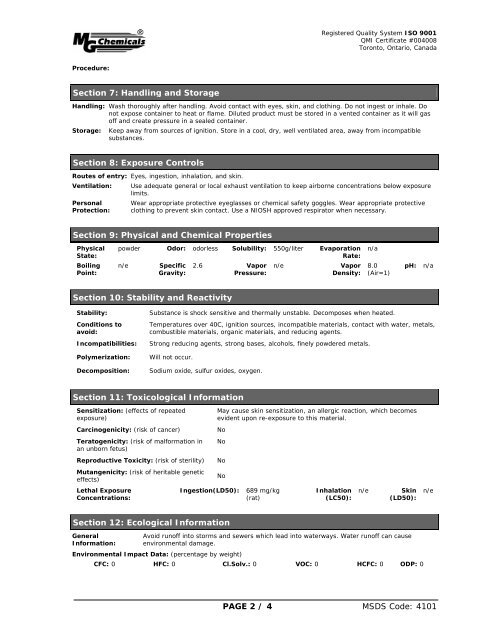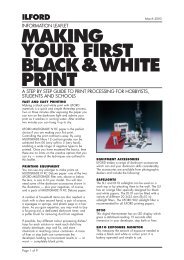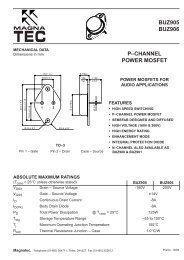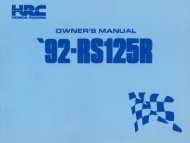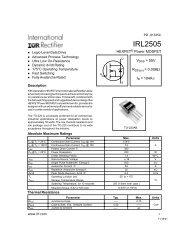MSDS 407C - aerosol
MSDS 407C - aerosol
MSDS 407C - aerosol
Create successful ePaper yourself
Turn your PDF publications into a flip-book with our unique Google optimized e-Paper software.
Registered Quality System ISO 9001<br />
QMI Certificate #004008<br />
Toronto, Ontario, Canada<br />
Procedure:<br />
Section 7: Handling and Storage<br />
Handling: Wash thoroughly after handling. Avoid contact with eyes, skin, and clothing. Do not ingest or inhale. Do<br />
not expose container to heat or flame. Diluted product must be stored in a vented container as it will gas<br />
off and create pressure in a sealed container.<br />
Storage: Keep away from sources of ignition. Store in a cool, dry, well ventilated area, away from incompatible<br />
substances.<br />
Section 8: Exposure Controls<br />
Routes of entry: Eyes, ingestion, inhalation, and skin.<br />
Ventilation:<br />
Personal<br />
Protection:<br />
Use adequate general or local exhaust ventilation to keep airborne concentrations below exposure<br />
limits.<br />
Wear appropriate protective eyeglasses or chemical safety goggles. Wear appropriate protective<br />
clothing to prevent skin contact. Use a NIOSH approved respirator when necessary.<br />
Section 9: Physical and Chemical Properties<br />
Physical<br />
State:<br />
Boiling<br />
Point:<br />
powder Odor: odorless Solubility: 550g/liter Evaporation<br />
n/a<br />
Rate: n/e<br />
Specific<br />
2.6<br />
V apor n/e<br />
Vapor 8 .0<br />
Gravity: Pressure:<br />
Density: (Air=1)<br />
pH:<br />
n/a<br />
Section 10: Stability and Reactivity<br />
Stability:<br />
Conditions to<br />
avoid:<br />
Incompatibilities:<br />
Polymerization:<br />
Decomposition:<br />
Substance is shock sensitive and thermally unstable. Decomposes when heated.<br />
Temperatures over 40C, ignition sources, incompatible materials, contact with water, metals,<br />
combustible materials, organic materials, and reducing agents.<br />
Strong reducing agents, strong bases, alcohols, finely powdered metals.<br />
Will not occur.<br />
Sodium oxide, sulfur oxides, oxygen.<br />
Section 11: Toxicological Information<br />
Sensitization: (effects of repeated<br />
exposure)<br />
Carcinogenicity: (risk of cancer)<br />
Teratogenicity: (risk of malformation in<br />
an unborn fetus)<br />
Reproductive Toxicity: (risk of sterility)<br />
Mutangenicity: (risk of heritable genetic<br />
effects)<br />
Lethal Exposure<br />
Concentrations:<br />
May cause skin sensitization, an allergic reaction, which becomes<br />
evident upon re-exposure to this material.<br />
No<br />
No<br />
No<br />
No<br />
Ingestion(LD50):<br />
689 mg/kg<br />
(rat)<br />
Inhalation<br />
n/e<br />
( LC50):<br />
S kin<br />
(LD50):<br />
n/e<br />
Section 12: Ecological Information<br />
General<br />
Information:<br />
Avoid runoff into storms and sewers which lead into waterways. Water runoff can cause<br />
environmental damage.<br />
Environmental Impact Data: (percentage by weight)<br />
CFC: 0 HFC: 0 Cl.Solv.: 0 VOC: 0 HCFC: 0 ODP: 0<br />
PAGE 2 / 4 <strong>MSDS</strong> Code: 4101


